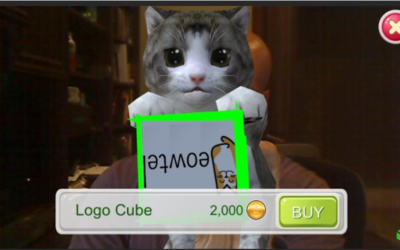The Observer Effect – How Clicks Changed Advertising

In physics, the Observer Effect theory tells us that observing a phenomenon necessarily and inevitably causes that phenomenon to change. This most commonly refers to instruments of measurement interfering with the results of an experiment. In advertising, the ways that we have come to measure engagement and effectiveness have influenced the popularity of certain mechanics. Popular ad inventory types – such as unskippable videos and interstitial ads – aren’t necessarily more effective. In fact, our own data shows that they are generally less effective. Their popularity stems from the fact that they are easier to quantify and this has narrowed the scope of advertising, particularly in digital formats.
Everything Clicks Into Place
For games, measuring one particular metric has had a huge impact on the type of ads most commonly implemented. The industry has prioritized Clickthrough Rate (CTR) almost to the point of tunnel vision. CTR is useful because it documents user interest in convenient and clear terms, in real time (or certainly close to it). When evaluating two similar clickable ads, there is no more accurate or reliable way to weigh up which is more effective than CTR.
The trouble is this: advertisers have naturally shrunk away from alternate forms of digital advertising and become instinctively reluctant to adopt those which don’t provide specific attribution. Pure awareness campaigns like sponsors on olympians’ track vests or logos flashed across Times Square provide no attribution whatsoever and they can’t leverage clickable ads. They are still among the most sought-after and expensive ad placements available. Chevrolet won’t sell a car with clickable ads but it pays well over $60 million every year to have its badge adorn Manchester United FC’s famous red shirts.
The Proof is in the Placement
According to Marketing Magazine, 2018 is the first year in which digital ad spend is set to eclipse television ad spend. People aren’t suddenly becoming susceptible to influence just because they can directly interact with ads. Moreover, it is the ‘traditional’ ad formats like TV, print and radio that consumers trust most readily. Online pop-ups, social media, mobile and banner ads rank lowest – despite their interactivity. Ironically, while clickable ads require very little guesswork when it comes to attribution, they are greatly overestimated in terms of audience impact.
Global market research giant, Ipsos, found last year that 85% of marketing professionals believe audiences to be subconsciously influenced by the brands that they see all around them. 86% felt that branded integrations like product placements were an effective way to reach audiences. Almost half of those surveyed said that they believed their clients would be investing in branded integrations during the coming year. Why then, are games stuck on clickable ads?
Interaction Interference
The proof of good advertising rarely manifests itself in an easily traceable user journey but, with CTR practically cemented as the gold standard of attribution, developers have become more likely to create ads that encourage players to click. If the rate of interaction is seen as the best indicator of success, audience interaction becomes a necessary part of successful advertising. This inevitably affects the gameplay experience, with interactive – and therefore interruptive – ads jarring game flow.
Stripped down to its fundamental purpose, advertising is about building trust and interest in a positive brand image on a consumer journey from recall to top-of-mind awareness and affinity.
The problem with in-game ads right now is that they’ve lost a crucial step in the process. Instead of making players want to engage with ads, they are happy to simply make players engage. Having done our own research to corroborate that of others, we know that people react much more positively to user-initiated ad models than mandatory and interruptive ones. Not every clicker is a happy one – just ask anyone that has ever struggled to close a deceptively designed pop-up.
Back to Science
“Nature does not know what you are looking at, and she behaves the way she is going to behave whether you bother to take down the data or not.” – Dr. Richard Feynman
More sophisticated attribution should always be an aim, of course, but the cost of ‘better’ data can sometimes outweigh its value. If the act of measuring success begins to change the definition of success itself, something has gone wrong. As marketers, our current obsession with click-based attribution is causing us to neglect incredibly worthwhile approaches to advertising that are proven to impact players more and gameplay experiences less.
AdInMo is a platform for programmatically integrating brand campaigns directly into eSports, AR & VR, and mobile gameplay – like dynamic product placement for games. If you are an advertiser that wants to create authentic and memorable brand experiences for your audiences, or a game developer wanting to make more revenue for your games, contact us!
More…
We’re hiring an SDK developer
Job Description – SDK Developer (Unity + Unreal), Full-time / Permanent, Edinburgh Are you not entertained? Love free-to-play games? Hate all those ads? We do too, and we’re doing something about it! We are: AdInMo is the leading Dynamic In-Game...
Techstart Ventures backs in-game ad platform AdInMo in $500K seed funding round
AdInMo appoints ex-delta DNA co-founder Chris Wright as Chief Technology Officer 20th, May 2020, Edinburgh: AdInMo, the programmatic ad platform for video games, has secured a $500K investment round led by Techstart Ventures, a leading investor in start-ups across...
Introducing AdInMo’s impression checker tool: optimising ad revenue before deployment
For developers, placing ads in games has historically been an area of headaches and compromises. We all know that traditional in-game advertising sucks; this is exactly why AdInMo offers an alternative solution where the ads placed are non-interruptive, and are...




